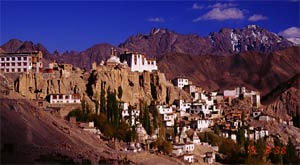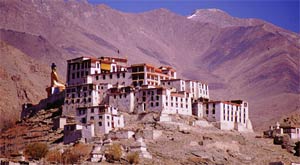Monasteries
Out of the twelve or so major monasteries or Gompas situated on or near the Indus, the most famous from the heritage view point is that of Alchi, called Alchi Choskor (religious conclave), on account of its ancient wall frescoes dating from the 11th and 12th centuries, which pre-date the Tibetan style of paintings and art syle seen in all the other Gompas of the region.
The other major monasteries of the Indus Valley are those of Hemis, Chemrey and Stakna, all of which were founded under the direct patronage of members of the ruling Namgyal dynasty. Hemis monastery, together with that of Hanle near the Tibetan border, was founded at the instance of King Singge Namgyal, while Chemrey was established by his wife after his death as a funerary act of merit. All these monasteries belong to the Druk-pa Kragyut school of Tibetan monasticism.
The reformist Gelugs-pa, or Yellow-Hat sect, is also well represented in central Ladakh by the monasteries of Thiksey, Likir, Ri-dzong and Spituk, and the branch monasteries of Stok, Sabu and Sankar. Ri-dzong, situated a few kilometers up a side-valley from Uley-Tokpo, was founded only a century and a half ago and is well known for the strict code of living for its resident monks as envisaged by its founder. Matho Gompa, nestling along the southern slopes of the Indus valley represents the smaller Saskyapa monastic sect, and is famous for its annual "Festival of the Oracles" which is eagerly awaited by the local people for the predictions of the oracles on the future course f events in the region.
 |
|
The other major monastic order of the Druk-pa school, the Drigung-Kargyut sect, is represented by the major monasteries of Phyang & Lamayuru. Both these monasteries house sizeable communities of monks. Headed by a common incarnate incumbent, these monasteries have smaller branches in different parts of Ladakh.
The Ladakh monasteries are repositories of exquisite murals, gilded statues, religious icons, carvings, scrolls etc. built up through the ages. They remain alive with the devotions of monks, young and old. Here it is possible to receive a lama's blessing, consult an astrologer about your future, hear the wail of a horn echoing from the mountain walls, and witness a lifestyle passed down intact through the ages. Visiting these monasteries is indeed an uplifting and learning experience.
| |
 |
Note for visitors to monasteries - The monasteries are the fountainhead of Buddhist religion and culture of Ladakh. Visitors are advised to respect their sanctity and appreciate their heritage importance. Shoes may have to be removed before entering some of the temples, while ladies are not allowed to enter the Gon-Khang or the room dedicated to the guardian divinities. Most of the region's major monasteries are open throughout the day and a caretaker Lama (Kom-ngyor) is available to show visitors around. Some of the less visited monasteries have special opening hours as in the case of the Namgyal Tsemo, Shey Palace etc. Check the timings before proceeding to these places. |

